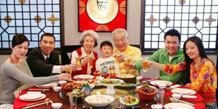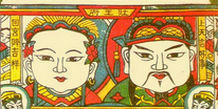

Chinese people start their preparations for the Spring Festival more than 20 days early.

As an artistic decoration, the Chinese knot is simple and auspicious. It emits strong national and rural flavor.

The tiger is crucial in Chinese culture. It has been used as a symbol of power, strength and awe. Tiger ranks third in the Chinese Zodiac and the beast is regarded as the ruler of all animals.

Dragon dance is a kind of folk dance particularly performed during the Spring Festival, Chinese lunar New Year.

Lion is the king of animals. In Chinese tradition, lion is regarded as a mascot, which can bring good luck.

Commonly known as the Festival of Po Wu,the fifth day of the Chinese New Year is a day when many taboos are believed to be broken.

The second day of the Chinese New Year is also known as “Kai Nian” in Chinese, meaning the beginning of a year.

Beijing has several fairs during the period. The fairs are held at various ancient temples, so they are called "temple fairs."

Lantern Festival is an important part of Spring Festival , and marks the official end of the long holiday.

With the adoption of the solar calendar, New Year's Day came to refer to the first day of the solar year.

During the Spring Festival, Chinese people in many places like to paste paper-cuts on windows for decoration, which help foster a festive atmosphere.

The annual Spring Festival Gala hosted by China Central Television has become an important part of the Chinese Lunar New Year celebration since 1983.

Lunar New Year's Eve, the last day of the old year, is one of China's most important traditional holidays.

Little New Year, which falls about a week before the lunar New Year, is also known as the Festival of the Kitchen God.

From red lanterns to special dumplings, China readies for Year of the Horse
Link : | China Daily | Chinaculture.org |